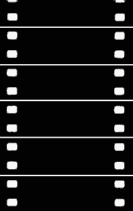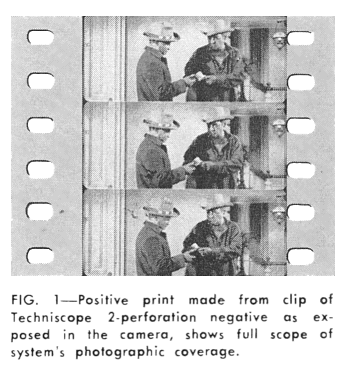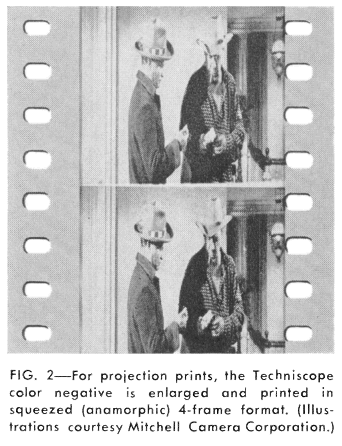 TECHNISCOPE -What It Is
And How It Works
In this new system of wide-screen color production, the negative frame height is reduced one-half for photography, effectively halving negative and processing costs.
B y F R E D E R I C K F O S T E R
TECHNISCOPE is the trade-name of a
new wide-screen film production
method developed by engineers of
Technicolor Corporation. It reduces
by one-half the amount of negative
film and negative processing required
for a color motion picture, This saving
is accomplished by reducing the negative picture area from the conventional
four-perforation frame size to one only
two-perforations in height. The frame
width remains the same, (See
"ASC
Recommendation No. 13" relating to the
Techniscope Process elsewhere in this
issue.-EDITOR.
 After the two-perforation negative is
processed it is optically printed at a
vertical ratio of 2-to-1, producing an
enlarged and squeezed image of the
original Techniscope frames on 35mm
color film in the form of a Technicolor
positive print. This process-cutting in
half the negative area required and
then enlarging it two times in making
the release print-effects a substantial
economy in production. A motion picture ordinarily requiring 15,000 feet
of color negative requires only half as
much or 75,000 feet in the Techniscope
process. This, says Technicolor Corporation. can save producers between
$15,000 and $20,000 in "front end"
production costs for a motion picture
in color.
After the two-perforation negative is
processed it is optically printed at a
vertical ratio of 2-to-1, producing an
enlarged and squeezed image of the
original Techniscope frames on 35mm
color film in the form of a Technicolor
positive print. This process-cutting in
half the negative area required and
then enlarging it two times in making
the release print-effects a substantial
economy in production. A motion picture ordinarily requiring 15,000 feet
of color negative requires only half as
much or 75,000 feet in the Techniscope
process. This, says Technicolor Corporation. can save producers between
$15,000 and $20,000 in "front end"
production costs for a motion picture
in color.
To use the Techniscope system requires a standard 35mm motion picture camera modified for the process,
which involves changing the pull-down
from four perforations to two, and the
aperture proportionately. The modification for most cameras can readily be
removed at any time to permit straight-forward four-sprocket hole photography. Technicolor points out,
Technicolor does not supply cameras
for the Techniscope process, nor does
the company perform the required
camera modification. This service is
offered by various camera manufacturers and camera distributors. Mitchell
Camera Corporation, whose 35mm
studio cameras dominate the sound
stages of most film production centers,
was among the first to announce Techniscope conversions for Mitchell 35mm
cameras and Arriflex 35mm cameras. In an advertisement in American
Cinematographer for January, 1964.
Techniscope conversions for the Mitchell BNC and NC were quoted as "approximately $1.400 per camera," and
for the 35mm Arriflex. "approximately
$1,300," Birns & Sawyer Cine Equipment, in Hollywood. in the December,
1963, issue of American Cinematographer, announced that the company will
". . . sell Techniscope modified cameras. rent Techniscope cameras, or
make Techniscope modifications on
your camera." The offer specified
Mitchell and Arriflex cameras.
More recently, the Arriflex Corporation of America, importers and distributors of Arriflex cameras and
equipment, has announced the availability of a new Arriflex-35, model
1113-T. for use in the Techniscope
process, It stated the camera features
a 2-perforation pull-down, film aperture
of 9.5mm x 22mm, and 200° shutter,
The camera, available in limited quantities. is priced at $2,100.
Among the feature films photographed to date in the Techniscope
process are "Law of The Lawless" and
"Stage Coach To Hell," both for
Paramount; "The Fastest Gun," Columbia; and Frank Sinatra's "For
Those Who Think Young" for United
Artists. From the point of photography,
Techniscope offers great depth of field
and razor sharp image definition,
thanks to the short focal length spherical lenses used on the camera. Although the ultimate release print is a
"squeezed" one, anamorphic lenses are
not required in the photography.
Further on the plus side, Technicolor
points out, is the doubling of the footage shot without need to change camera magazines-because the film footage required for a take is reduced by
one-half. Also, there is a reduction in
the length and number of short ends.
And, the shortened film transport in
the camera creates less camera noise
than one having the conventional four-
perforation movement.
 Although Techniscope work prints
are standard frame size, fit standard
35mm film editing equipment and projectors, it is the industry's film editors
who have expressed some reservations
about the Techniscope system. For one
thing, the system introduces a change
in the editor's customary procedure.
Film editor Frank Keller, who edited
the Sinatra-United Artists' release,
"For Those Who Think Young," writing in a recent edition of The Cinemeditor, official organ of the American
Cinema Editors, Inc., said: "From the
film editor's viewpoint there are a few
complications which must be kept in
mind as the eventual cut picture negative is set up in a particular manner.
Because of extremely narrow frame
lines, which would cause negative
splices to be visible in the projected
picture, each scene of negative is cut
alternately on A-and-B rolls and the
splices made on overlapping frames.
This means that the editor must allow
for a few "waste frames" at the beginning and end of every cut in the picture. An allowance of four waste
frames is requested by Technicolor,
although in a tight editing problem
two or three extra frames will suffice."
"The editing complications begin,"
Keller points out, "when an intercut is
needed in a reaction scene. For example, in `For Those Who Think
Young,' there is a scene in which
James Darren looks off-stage, sees
Pamela Tiffin across a room, and immediately turns back and speaks a line
of dialogue to a companion. Ordinarily,
an editor might need to lose only one
frame in order to intercut the viewpoint scene of Pamela Tiffin, but with
this process eight frames are lost at
that point to accommodate the four
waste frames required after Darren
looks off - and to accommodate the four
waste frames ahead of the cut in which
Darren turns back. This might cause
the cutting to appear sharper than
normal.
Although Techniscope work prints
are standard frame size, fit standard
35mm film editing equipment and projectors, it is the industry's film editors
who have expressed some reservations
about the Techniscope system. For one
thing, the system introduces a change
in the editor's customary procedure.
Film editor Frank Keller, who edited
the Sinatra-United Artists' release,
"For Those Who Think Young," writing in a recent edition of The Cinemeditor, official organ of the American
Cinema Editors, Inc., said: "From the
film editor's viewpoint there are a few
complications which must be kept in
mind as the eventual cut picture negative is set up in a particular manner.
Because of extremely narrow frame
lines, which would cause negative
splices to be visible in the projected
picture, each scene of negative is cut
alternately on A-and-B rolls and the
splices made on overlapping frames.
This means that the editor must allow
for a few "waste frames" at the beginning and end of every cut in the picture. An allowance of four waste
frames is requested by Technicolor,
although in a tight editing problem
two or three extra frames will suffice."
"The editing complications begin,"
Keller points out, "when an intercut is
needed in a reaction scene. For example, in `For Those Who Think
Young,' there is a scene in which
James Darren looks off-stage, sees
Pamela Tiffin across a room, and immediately turns back and speaks a line
of dialogue to a companion. Ordinarily,
an editor might need to lose only one
frame in order to intercut the viewpoint scene of Pamela Tiffin, but with
this process eight frames are lost at
that point to accommodate the four
waste frames required after Darren
looks off - and to accommodate the four
waste frames ahead of the cut in which
Darren turns back. This might cause
the cutting to appear sharper than
normal.
"Other such complications occurred
when unplanned inserts were intercut
into scenes, and when a jump-cut became necessary to eliminate an action
stall. A short jump-cut of one or two
frames cannot be handled.... Another
present handicap, which should be
alleviated in the near future, is the existence of only one optical printer in
the industry to handle this two-
sprocket-hole negative."
Among the several technical advantages of the Techniscope process,
Keller points out, is the fact that in
any negative recutting there is no need
to lose a frame of any adjoining scene,
using the A-and-B roll negative set-up.
It is generally believed that the
Techniscope process with its cost-saving
factors will encourage producers of
low-budget films to convert to color
photography, and possibly encourage
more film production in general. |
